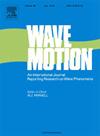缓坡上快速重力流中的两层滚波
IF 2.5
3区 物理与天体物理
Q2 ACOUSTICS
引用次数: 0
摘要
采用考虑惯性效应的综合层模型,对缓坡上两层重力流中横摇波的非线性发展进行了数值研究。在密度和粘度比的实际范围内,研究了由局部扰动引起的周期性滚波和滚波包。当最初引入局部扰动时,两层的滚波包中的前导波(称为“领跑者”)可能会产生非常大的峰值深度和速度,并且随着波包向下游传播而增加。上层轧辊波和下层轧辊波表现出不同的特征。上层横摇波幅值明显大于下层横摇波幅值。此外,上层周期滚转波或前流道的峰值总是与类激波前重合,而低层振幅足够大的前流道的峰值则通过光滑的剖面与类激波前相连。利用扩展到二维的积分层模型对三维两层流动进行模拟,也证实了类似的领跑者存在。然而,由于波前的横向扩散,三维前导波的峰值深度和速度明显小于单向前导波。本文章由计算机程序翻译,如有差异,请以英文原文为准。
Two-layer roll waves in rapid gravity currents on mild slopes
The nonlinear development of roll waves in two-layer gravity currents on mild slopes are numerically investigated using an integrated layer model including inertia effect. Periodic roll waves and roll-wave packets initiated by localized disturbance are examined for a realistic range of density and viscosity ratios. When a localized disturbance is introduced initially, the leading wave in the roll-wave packet for both of the layers (referred to as the ”front runner”) could develop exceedingly large peak depth and velocity which increase as the wave packet travels downstream. The upper-layer roll wave and lower-layer roll wave show different characteristics. The amplitude of upper-layer roll wave was found to be significantly larger than that of the lower-layer roll wave. Furthermore, peaks of upper-layer periodic roll waves or front runners always coincide with the shock-like wavefront, while peaks of lower-layer front runners with sufficiently large amplitudes are connected to the shock-like wavefront by a smooth profile. Simulations for three-dimensional two-layer flows using the integrated layer model extended to two dimensions demonstrate similar front-runner existence. However, the three-dimensional front runner has remarkably smaller peak depth and velocity than its unidirectional counterpart due to the transversal spreading of the wavefront.
求助全文
通过发布文献求助,成功后即可免费获取论文全文。
去求助
来源期刊

Wave Motion
物理-力学
CiteScore
4.10
自引率
8.30%
发文量
118
审稿时长
3 months
期刊介绍:
Wave Motion is devoted to the cross fertilization of ideas, and to stimulating interaction between workers in various research areas in which wave propagation phenomena play a dominant role. The description and analysis of wave propagation phenomena provides a unifying thread connecting diverse areas of engineering and the physical sciences such as acoustics, optics, geophysics, seismology, electromagnetic theory, solid and fluid mechanics.
The journal publishes papers on analytical, numerical and experimental methods. Papers that address fundamentally new topics in wave phenomena or develop wave propagation methods for solving direct and inverse problems are of interest to the journal.
 求助内容:
求助内容: 应助结果提醒方式:
应助结果提醒方式:


